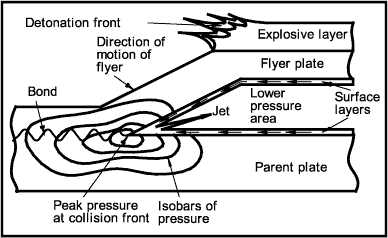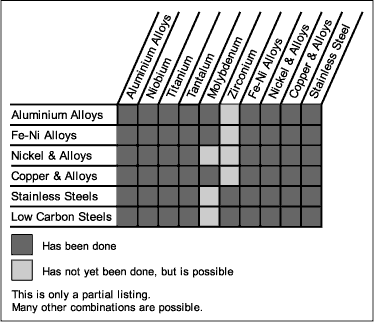Explosive welding
by Tom Howes
What is it?
The fearsome destructive power of explosives can be harnessed to provide a unique joining method, known as Explosive Welding.
To form an explosive weld the following conditions need to occur:
- Two surfaces that need to be joined are initially spaced at a small distance (stand-off distance).
- An explosive force brings these two surfaces together progressively at a collision front. The collision front's velocity must be lower than the speed of sound in the materials, so that the shock wave precedes the bond being formed. If not,
the shockwave would interfere with the contacted surfaces preventing a bond occurring.
- The interfacial pressure at the collision front must exceed the yield strength of the materials, so that plastic deformation will occur.
A jet of metal is formed just ahead of the collision front, comprising of the two component surfaces, which is finally ejected from the interface. The surfaces and any surface contaminants are removed in the jet. Behind the collision front, the now
clean surfaces bond, under extreme pressure, in the solid state. This dynamic welding situation is shown in Fig.1. In cross section, the materials usually bond together in an undulating wave form and the process can weld a parent plate of
thickness 0.025mm to over 1m (the maximum flyer plate thickness is one third that of the parent plate). Up to 30m2 can be welded in one explosion.
 |
Fig.1.
Dynamic situation at the collision front showing the jetting mechanism
|
Current Status
Explosive welding was first recognised as a solid state process in 1944 when solid state welding had occurred between two metallic discs which had been in contact with a detonator. It was not until the 1960s that the process was exploited
commercially throughout the world. The process was mainly used to clad large areas of one metal with another. The materials that are commonly clad are shown in Fig.2.
 |
Fig.2.
Common clad material combinations
|
Current issues
More recently the process has moved away from simple cladding and is used to produce corrosion resistant pressure vessels, transition joints for shipbuilding, electrical busbars and heat exchangers for nuclear installations. Future developments of
the technique might create advanced composite structures for the aerospace industry.
Benefits
The advantages of explosive welding over conventional welding techniques are as follows:
- Used to join dissimilar metals
- Achieves high bond strength
- Maintains parent metal qualities
- Achieves welds over large areas
- Requires low capital outlay
- Produces minimal distortion of parent metals
- Enables remote welding to take place
- Enables welding in hostile environments
Risks
Explosive welding requires a remote location, has the danger of handling and storing explosives and therefore needs strict security. The technique is restricted to a batch process which limits the speed of weld production.
|

